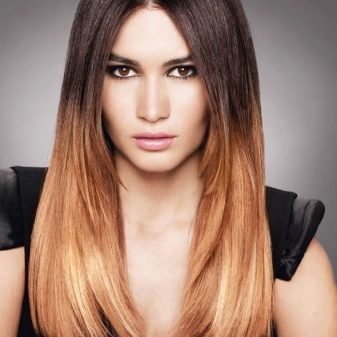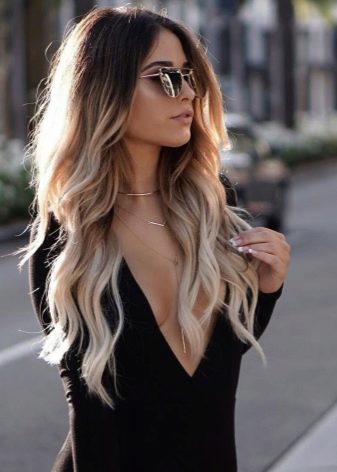Ombre for long hair: types and technique of dyeing

For several seasons, such a beauty technique for coloring hair as ombre has been at the peak of popularity. This coloring makes its owner stylish, effective and unlike the rest. The ombre looks most impressive on long curls.
Peculiarities
The ombre technique is considered an ideal solution for ladies who seek to bring a touch of novelty to their look, but are not ready for any radical changes. With the help of a gradient, they set off the native hair color or emphasize the spectacular color of dyed curls. The essence of the method comes down to the design of the transition between dark and light shades.




The procedure has a lot of advantages:
- unlike complete dyeing, it does much less harm to the hair, since not all hair is toned here, and the root zone is completely unaffected;
- allows you to quickly and effectively change your appearance;
- with the right choice of shades, it makes the image as natural as possible;
- visually adds volume and color depth to hair;
- as it grows, the border between native and dyed hair is almost invisible, therefore, such toning does not need to be corrected more often than once every 3 months;
- hides the flaws in appearance and emphasizes its dignity;
- optimal for haircuts with bangs;
- if the haircut is tired, then you can return to the original image without sacrificing the length.


However, there were some drawbacks.
- When using the technique on dark or red hair, in most cases, discoloration of the ends is required, since these pigments are rather persistent and do not easily dye.
- Not suitable for women with short hair.The only exception can be contour ombre, when only the border of the haircut is painted.
- If the hair is damaged by perm or frequent dyeing, then lightening is not recommended. This is fraught with even greater overdrying of the hair, which leads to fragility and split ends.
- The procedure, if carried out by professional colorists, is very expensive, especially for elongated curls.
- Coloring in the ombre style requires experience and skill, not every hairdresser is able to cope with this technique - it is almost impossible to achieve a perfect gradient with insufficient skill.


Varieties
Modern ombre comes in several versions. Let's take a look at the most popular techniques.
- Classic - the most popular technique, which involves a combination of two shades. Such coloring is also called two-tone, while the border between two colors can be either blurred or clearly defined. Usually, in this version, the roots are left darker, and at the ends the hair is lightened. The main thing is that both tones should be harmoniously combined with each other, therefore, as a rule, shades that are as close to natural as possible are used here - light brown and nutty, coffee and honey, chocolate and wheat.

- Multitonal - unlike the classical technique, several shades of a natural color palette are used here, from chocolate to caramel or even platinum. The transitions are made smooth, thanks to which soft overflows are created on the head. Such an ombre is quite difficult to perform, so it is made exclusively in beauty salons.


- Colored - coloring is optimal for women who like to stand out from the crowd, it allows them to become more vibrant, both in the literal and figurative sense of the word. This ombre is the most radical way to change your image. Usually, rich juicy shades are used for such coloring - burgundy, marsala, pink, purple and blue. By combining them with each other, you can achieve extremely unexpected creative effects.

- The reverse - this technique involves the design of a gradient from light at the roots to dark at the edges. Such a solution looks harmoniously in combination with purple or red edges of the hair.


- Ombre bronzing - this option is optimal for the fair sex, who strive to achieve the maximum naturalness of the color scheme. As a rule, the root zone (about 8-10 cm) remains darkened, the strands in this area are painted in chocolate and coffee shades, and the rest of the mop is tinted according to the bronzing principle, when shades of several colors gently flow into each other, creating the effect of slightly burnt out on hot sun hair.

- Scandinavian - this is a very original technique, here light, almost white roots turn into black, less often the edges are tinted with red, purple and crimson. This method is optimal for blonde women.

- With a sharp border - if the classical technique involves the creation of soft transitions from one tone to another, then in this case the border is clearly traced. Usually, such an ombre is made with monochrome coloring, in most cases black and white colors are used here.


- Partial - this staining resembles highlighting, but the strands are colored not from the root zone, but from the conditional middle. This solution allows you to achieve minimal damage to the heap, because the technique is used even for thin and weakened strands.
- Three-zone - in this case, the hair is divided in length into three horizontal sections - root, middle, and lower. Usually, the hair near the roots and along the edges is dyed lighter, and in the central zone it is drawn with a contour color.

Color selection
For a long time it was believed that ombre on long hair is suitable only for brunettes, but over time, dyeing technologies have changed, and today a gradient is created on curls of any color.
Classic ombre is recommended for blondes using transitions to lighter colors, thus creating the effect of sun-burnt ends. Moreover, if the hair is amber or light chestnut, then transitions to golden, caramel and wheat shades will be appropriate here, and if the natural range is closer to light brown-ash, then the edges can be decorated either with a platinum blonde, or, conversely, made a little darker ...


When decorating the transitions from brown and black to caramel, chocolate chestnut colors are also used.
Girls with dark blond curls the design of the tips in a pearl color is suitable, it will create an effective strong accent, while the border can be both clear and blurred.
Dark strands look great in a gradient with reddish tones - copper, reds and tangerine tones are popular here.



Execution technique
When dyeing long hair, pay particular attention to the following recommendations:
- girls with long hair can leave the root zone unpainted, this will cause minimal damage to the curl;
- when performing a color gradient, only the tips are tinted;
- if the haircut involves a bang, then it is better to leave it unpainted.
At home, you can try to make a classic ombre on only the ends of the hair. For work you will need;
- clarifier;
- a bowl for diluting paint;
- brush or sponge;
- foil;
- latex gloves;
- a cape or old towel;
- comb.

The step-by-step instructions for carrying out an ombre on long hair involve several main stages.
- The hair is divided into 4 zones using a cross-section.
- In containers made of glass or porcelain, the dye composition is diluted and applied to the curls from the middle to the ends.
- After 20-25 minutes, the paint must be washed off without shampoo,
- Wet hair is combed, and then, using a horizontal parting, it is divided into 2 parts. Each is divided into thin strands and the lightened area is covered with paint of the desired shade. Coloring is carried out using foil.
- The composition is kept on the hair for the time specified by the manufacturer, after which it is washed with water and shampoo and a hair balm is applied.
There is another option for a home ombre. In this case, the hair is conventionally divided into 3 horizontal sections. On the first one, a clarifying composition is applied and kept for 15-20 minutes, after which the paint is applied again, but already the middle zone is captured, wrapped in foil and kept in accordance with the instructions. After removing the paint, the hair is tinted and treated with a conditioner balm.


Care
Despite the fact that the technique is considered quite gentle, but like after all procedures involving the use of chemical dyes, dyed hair needs to be cared for. In order for the color to retain its original shade as long as possible, use sulfate-free shampoos, preferably those that remove the effect of yellowness - this is especially true with strong discoloration of individual strands.
Be sure to make masks at least once a week, they contribute to the restoration and regeneration of hair - preference should be given to professional formulations that contain silicone, proteins, vitamin and mineral complexes.
Do not get carried away with frequent styling with an iron and a curling iron, but if they cannot be avoided, apply a special thermal protective compound before that.
Constantly monitor the condition of the ends of the hair, at the first sign of the beginning of a split, immediately trim them from a professional master.

Successful examples
One of the most popular trends in recent seasons for the owners of black and dark blond curls is the ash ombre.In this case, a variety of shades of gray are used, which creates a rather unusual, but extremely effective image. This type of coloring is ideal for women of cold color type with white skin and light eyes. In this technique, the roots are left uncolored, the middle part of the hair is tinted black or steel, and the ends are lightened to a pure platinum or pearl blonde.


The "graphite" technique looks no less stylish, when a gradient is formed from dark hair at the crown to a silvery shade, and from it to blue or lilac.


Fair-haired girls in most cases prefer natural color schemes, such a play of tones looks natural and gives additional splendor to the hair.

Stylists advise fair-haired girls to experiment with red flowers - fair-haired itself is rather inexpressive, and orange tones make the look brighter and more dynamic.


Another trendy combination is red with pink, this ombre is suitable for all shades of light brown curls, while the look is quite delicate and very feminine.


Girls with light curls, in most cases, dye their hair so that the effect of regrown roots is obtained, while the root area is tinted with darker shades, and towards the ends, their color becomes lighter.


On blond ladies, the transition to pink or purple tones looks spectacular - this solution makes the image more stylish and daring.


Women with red hair can carry out a variety of fashion experiments and make transitions in both light and darker shades. If the hair is light red, combinations with sandy, caramel and honey tones will be optimal here, they will make the look softer. However, the opposite ombre is also appropriate, turning into burgundy and wine tones. This ombre looks especially stylish on brown-haired women with cascade hairstyles.



You will learn more about how to make an ombre for long hair in the following video.








